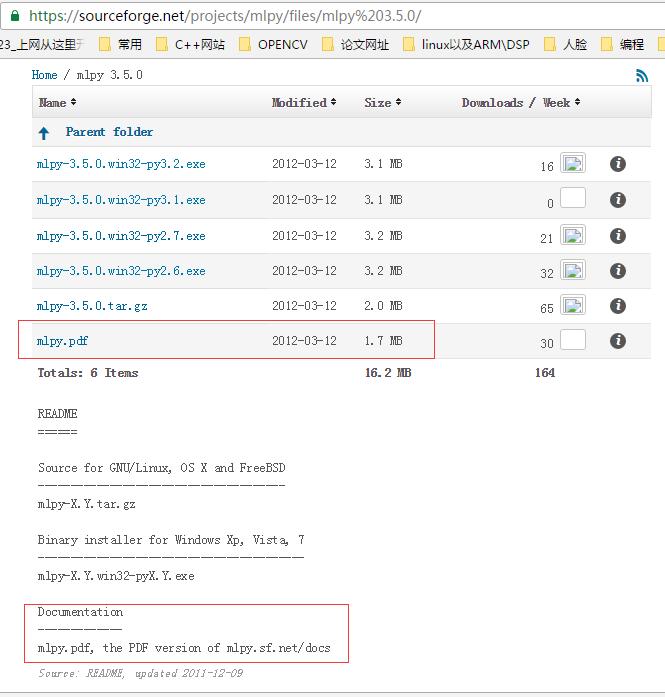mlpy机器学习库的介绍
1、Introduce
mlpy is a Python module for Machine Learning built on top of NumPy/SciPy and the GNU Scientific Libraries.
mlpy provides a wide range of state-of-the-art machine learning methods for supervised and unsupervised problems and it is aimed at finding a reasonable compromise among modularity, maintainability, reproducibility, usability and efficiency. mlpy is multiplatform, it works with Python 2 and 3 and it is Open Source, distributed under the GNU General Public License version 3.
2、Documentation
(1)online Documentation:http://mlpy.sourceforge.net/docs/3.5/
(2)PDF Documentation:https://sourceforge.net/projects/mlpy/files/mlpy%203.5.0/
3、CONTENTS
2 Introduction
2.1 Conventions
3 Tutorial
3.1 Tutorial 1 - Iris Dataset
4 Linear Methods for Regression
4.1 Ordinary Least Squares
4.2 Ridge Regression
4.3 Partial Least Squares
4.4 Last Angle Regression (LARS)
4.5 Elastic Net
5 Linear Methods for Classification
5.1 Linear Discriminant Analysis Classifier (LDAC)
5.2 Basic Perceptron
5.3 Elastic Net Classifier
5.4 Logistic Regression
5.5 Support Vector Classification
5.6 Diagonal Linear Discriminant Analysis (DLDA)
5.7 Golub Classifier
6 Kernels
6.1 Kernel Functions
6.2 Kernel Classes
6.3 Functions
6.4 Centering in Feature Space
6.5 Make a Custom Kernel
7 Non Linear Methods for Regression
7.1 Kernel Ridge Regression
7.2 Support Vector Regression
8 Non Linear Methods for Classification
8.1 Parzen-based classifier
8.2 Support Vector Classification
8.3 Kernel Fisher Discriminant Classifier
8.4 k-Nearest-Neighbor
8.5 Classification Tree
8.6 Maximum Likelihood Classifier
9 Support Vector Machines (SVMs)
9.1 Support Vector Machines from [LIBSVM]
9.2 Kernel Adatron
10 Large Linear Classification from [LIBLINEAR]
11 Cluster Analysis
11.1 Hierarchical Clustering
11.2 Memory-saving Hierarchical Clustering
11.3 k-means
12 Algorithms for Feature Weighting
12.1 Iterative RELIEF
13 Feature Selection
13.1 Recursive Feature Elimination
14 Dimensionality Reduction
14.1 Linear Discriminant Analysis (LDA)
14.2 Spectral Regression Discriminant Analysis (SRDA)
14.3 Kernel Fisher Discriminant Analysis (KFDA)
14.4 Principal Component Analysis (PCA)
14.5 Fast Principal Component Analysis (PCAFast)
14.6 Kernel Principal Component Analysis (KPCA)
15 Cross Validation
15.1 Leave-one-out and k-fold
15.2 Random Subsampling (aka MonteCarlo)
15.3 All Combinations
16 Metrics
16.1 Classification
16.2 Regression
17 A Set of Statistical Functions
18 Canberra Distances and Stability Indicator of Ranked Lists
18.1 Canberra distance
18.2 Canberra Distance with Location Parameter
18.3 Canberra Stability Indicator
19 Borda Count
20 Find Peaks
21 Dynamic Time Warping (DTW) 21.1 Standard DTW 21.2 Subsequence DTW 22 Longest Common Subsequence (LCS) 22.1 Standard LCS 22.2 LCS for real series 23 mlpy.wavelet - Wavelet Transform 23.1 Padding 23.2 Discrete Wavelet Transform 23.3 Undecimated Wavelet Transform 23.4 Continuous Wavelet Transform 24 Short Guide to Centering and Scaling


























 628
628

 被折叠的 条评论
为什么被折叠?
被折叠的 条评论
为什么被折叠?








